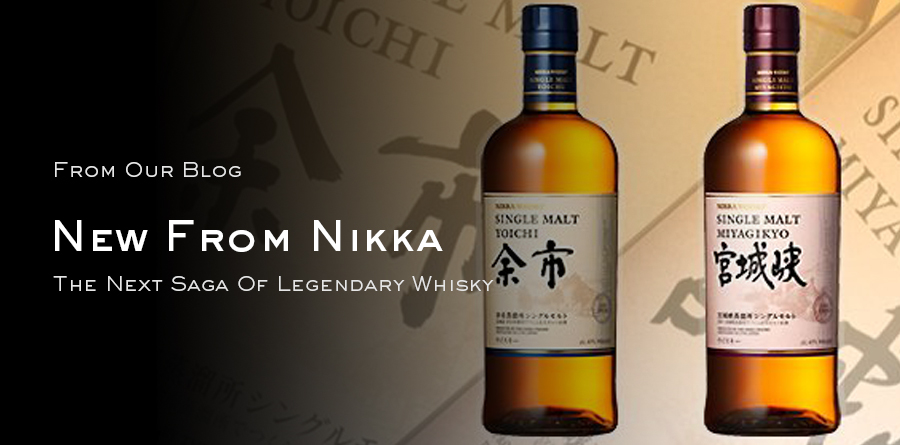If you have been following the news from the Japanese whisky biz, you know by now that both Nikka and Suntory are making drastic changes to their selection. Nikka, the company that runs on the DNA of its founder Masataka Taketsuru, is discontinuing their entire single malt lineup, shelving such favorites as Yoichi and Miyagikyo 10,12,15 and 20 Year Old. Furthermore Nikka is discontinuing their White Label Pure Malt, Tsuru 17, G&G, Hakata, The Blend, Malt Club, Hi-Nikka, All Malt, Black Nikka 8 Year Old and Black Nikka Special.
What on earth is going on here? As we reported a few months ago, the NHK television show Massan has taken Japan by such a storm that Nikka was bound to do a little restructuring — if they didn’t, there wouldn’t be any Nikka left on the market. The Japan-based Whisky World magazine asked the blenders responsible for the new lineup to tell us more about it.
On September 1, Nikka discontinued most of their old whisky lineup and released two non-age statements of their famous Yoichi and Miyagikyo. The announcement came as quite a shock to customers used to getting their Yoichi 15 Year Old or whatever is their fancy. What was the reason for this? According to Saku-san, one of Nikka’s chief blenders, Nikka has been experiencing a sales boom this year due to Massan (a popular NHK televisions series about the life of Masataka Taketsuru and his Scottish-born wife Rita), and while Nikka expected a sales increase, this explosion caught them by surprise. Therefore they had no choice but to put more whisky on the market faster, hence the new products.
But it’s not only Nikka who has had to resort to making changes — the whisky world in general is experiencing supply shortages due to increasing demand. Many Scottish distilleries, for example, are bringing out non-age statements these days.
The two new Nikka products were blended according to customers’ input. The non-age statement it does not mean that all the whisky used in the blend is three years old; much of it is actually 10–11 years old. In fact, the non-age statements are meant to be similar to the 12 Year Old or 15 Year Old in the sense that they have a powerful taste.
For those who don’t know, the age stated on the bottle reflects the youngest whisky in the bottle. So a 12 Year Old might be only 10 percent 12-year-old whisky, while the rest is 15–30 years old. But it’s still a 12 Year Old whisky. The same goes for the non-age statement: A lot of the content in the bottle is far older than three years (the minimum age for whisky to be legally considered whisky).
How well do customers understand the differences between non-age statements and aged whiskies? Veteran whisky consumers of course know the difference; newer consumers, on the other hand, are often unaware.
The blending process for Nikka’s new whiskies took a lot of time as the blenders wanted to make sure that the quality was as high as possible. Of course customers don’t necessarily want the exact same taste they’ve had for years. Many want something new, as the blenders at Nikka were well aware.
However, the blenders did want to get as close to the 10 Year Old and the 12 Year Old as possible. And of course they also aimed to give the new whiskies that same Yoichi feel or Miyagikyo feel.
Where does that feel come from? The Yoichi distillery distills its whisky using coals, giving it a rich scent. The distillery also uses small pot stills and more peat than Miyagikyo generally does. The word peaty pretty much sums up what comes from Yoichi, and the blenders tried to maintain this feature in the new non-age statement.
Miyagikyo, on the other hand, uses chimney stills and large steel stills, so the whiskies from that distillery tend to be lighter. People once described Yoichi as a highland distillery and Miyagikyo as a lowland distillery, but a better analogy I think would be that Yoichi produces Island whisky and Miyagikyo Speyside whisky.
Miyagikyo whiskies tend to be fruity and light, compared to the heavier, peated whiskies from Yoichi. The new whiskies are intended to reflect that and give consumers the same sense of Yoichi-ness and Miyagikyo-ness they’ve come to love. If anything, the non-age statements are a bit more extreme in taste, with the Miyagikyo being even more fruity than normal.
International customers are more familiar with Yoichi and tend to buy it because of the prestige attached to the name. But ultimately, the decision to buy one or the other comes down to your taste: If you like heavy and peated whiskies then Yoichi is for you, but if you like your whisky lighter and fruity then Miyagikyo is the better bet. In any case, we at dekantā recommend that you try both, as the newest stock arriving from Miyagikyo and Yoichi is quite affordable. Check out our current selection.
Based on an article from Whisky World
Published: October 30, 2015Author: Henry Baldvin
